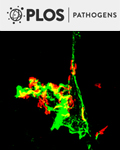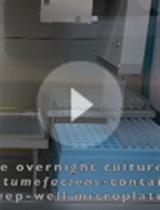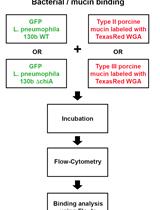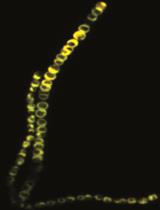- EN - English
- CN - 中文
Growth Recovery Assay and FACS-based Population Sorting Following Territorial Exclusion in Proteus mirabilis
奇异变形杆菌被领土排斥后生长恢复测定和基于FACS的群体分类
发布: 2020年03月05日第10卷第5期 DOI: 10.21769/BioProtoc.3543 浏览次数: 4962
评审: Kristin L. ShinglerYoko EguchiChao Jiang
Abstract
Many bacteria take part in self recognition and kin discrimination behavior using contact-dependent effectors. Understanding the effects these effectors cause is important to explain bacterial community formation and population dynamics. Typically, kin discrimination effectors are toxins that kill target cells; their effect is therefore obvious and easily measurable. However, many self-recognition effectors, such as the Proteus mirabilis Ids system, are non-lethal and do not cause obvious physiological changes in target cells. Previously, experimental techniques to probe cells experiencing non-lethal kin recognition have been limited. Here we describe a technique to reliably isolate cells deemed self and non-self through Ids self-recognition for downstream phenotypic analysis. Liquid cultures of fluorescently labeled self-recognition mutants are mixed together and inoculated on swarm-permissive agar. Mixed swarms are harvested, and each strain is isolated through fluorescence-activated cell sorting (FACS). The growth rate of each strain is measured on a plate reader. This protocol is adaptable for other bacterial species. We describe briefly how sorted particles can be used for other analyses such as RNA-Seq library preparation.
Keywords: Contact-dependent effectors (依赖接触的效应器)Background
Many organisms have evolved adaptations to community living. One common mechanism present throughout nature is kin discrimination: preferential treatment of close kin and hindrance of non-kin (Smith, 1964). Well studied examples of bacterial kin discrimination include contact-dependent inhibition (CDI) (Aoki et al., 2009; Garcia et al., 2016) and toxin transfer through type IV and type VI secretion systems (Brunet et al., 2013; Souza et al., 2015). Typically, kin discrimination in bacteria is mediated by exchange of toxic effector proteins, such as nucleases or peptidoglycan degrading enzymes (Alteri and Mobley, 2016). Each strain expresses characteristic effector-immunity pairs, and cells must either express the cognate immunity protein or die. Proteus mirabilis, however, makes use of a non-lethal self recognition system, the Ids system, to perform kin discrimination during swarming (Gibbs et al., 2008). P. mirabilis displays a sophisticated swarming phenotype on solid surfaces. After surface contact, a subset of cells differentiate into elongated “swarmer” cells that collectively travel outwards. Periods of swarming are regularly followed by non-expansion “consolidation” periods where swarmer cells differentiate into shorter stationary cells. Successive rounds of swarming and consolidation lead to a characteristic bullseye pattern on surfaces (Rauprich et al., 1996). While swarming, different P. mirabilis isolates express different variants of identity factors IdsD and IdsE. IdsD is transferred between cells in a contact-dependent fashion. If cells do not express a cognate IdsE they do not die but are instead forced out of cooperative swarm behavior in a phenomenon termed territorial exclusion. This behavior is due to forced induction into a persister-like state mediated by the alarmone (p)ppGpp (Tipping and Gibbs, 2019).
In lethal kin discrimination systems, progression can be measured through several methods: dilution assays, microscopy to visualize killing (e.g., Basler et al., 2013), or live-dead staining (Virta et al., 1998). Quantifying the efficacy of a non-lethal system is more difficult. The relative swarm extent in situ can be measured through microscopy or replica plating (Wenren et al., 2013), but these methods provide limited information about the swarm state, and none at all about the states of individual cells that have taken part in non-lethal kin discrimination. Isolation of cells from the greater swarm mass is therefore critical to enable their physiological state to be examined in more detail.
We have developed the first method for separating two populations of cells from a mixed P. mirabilis swarm using fluorescence-activated cell sorting (FACS), so that the state of cells that have taken part in self recognition behavior can be measured. This efficient and reliable protocol allows downstream examination of cells using several different methods. Here, we describe how to measure growth rate of cells that have experienced territorial exclusion. We have also used this method to generate samples for RNA-Seq library preparation, and describe our methods for doing so briefly. Furthermore, sorted cells can potentially be used to generate samples for other metabolic or biochemical assays. The protocol as described is optimized for separating P. mirabilis cells and could be adapted to isolate cells from swarms of other species such as Escherichia coli, Vibrio cholerae, Pseudomonas aeruginosa, and Providencia stuartii.
Materials and Reagents
Note: All materials and reagents are stable at room temperature. P. mirabilis strains are typically transported as stab cultures that are viable at room temperature.
- Disposable inoculation loop (Fisher, catalog number: 22-363-602 )
- Petri dishes (VWR, catalog number: 25384-168 )
- 50 ml conical tubes (Fisher, catalog number: 14-432-22 )
- 1.5 ml microcentrifuge tubes (Fisher, catalog number: 05-408-129 )
- 1-10 µl pipette tips (Fisher, catalog number: 07-000-854 )
- 20-100 µl pipette tips (Fisher, catalog number: 07-000-867 )
- 200-1,000 µl pipette tips (Fisher, catalog number: 07-000-350 )
- Disposable spreaders (Fisher, catalog number: 14-665-230 )
- Spectrophotometry cuvettes (VWR, catalog number: 97000-586 )
- 0.22 µm vacuum filter kit (Fisher, catalog number: 09-761-1 )
- FACS collection tubes (Fisher, catalog number: 50-187-1139 )
- 96-well flat-bottomed plates (Sigma-Aldrich, catalog number: M2936-100EA )
- Proteus mirabilis strain KAG107 (BB2000 constitutively expressing DsRed) (Gibbs et al., 2008) (available on request)
- Proteus mirabilis strain KAG966 (BB2000 ∆ids constitutively expressing GFPmut2) (Gibbs et al., 2008) (available on request)
- Tryptone (Fisher, catalog number: DF0123-17-3 )
- Yeast extract (Fisher, catalog number: DF0127-17-9 )
- Sodium chloride (NaCl) (Sigma-Aldrich, catalog number: S9888-500G )
- Oxoid CM55 agar (Fisher, catalog number: OXCM0055B )
- Glycerol (Sigma-Aldrich, catalog number: G7893-500ML )
- Bacto-agar (Fisher, catalog number: DF0140-01-0 )
- Magnesium sulfate (MgSO4) (Sigma-Aldrich, catalog number: M7506-500G )
- Nicotinic acid (Sigma-Aldrich, catalog number: N4126-100G )
- Sodium hydrogen phosphate dihydrate (Na2HPO4·2H2O) (Sigma-Aldrich, catalog number: 71645-1KG )
- Potassium hydrogen phosphate (K2HPO4) (Sigma-Aldrich, catalog number: 1051041000 )
- Sodium hydroxide (NaOH) (Sigma-Aldrich, catalog number: 795429-500G )
- Hydrochloric acid (HCl) (Sigma-Aldrich, catalog number: 320331-500ML )
- RNA-Protect solution (Qiagen, catalog number: 76526 )
- LB Broth (1 L) (see Recipes)
- CM55 swarm agar (1 L) (see Recipes)
- LSW- Agar (1 L) (see Recipes)
- Media (1 L)
- LSW supplemental mixture (50 ml)
- Phosphate-buffered saline (PBS) (see Recipes)
Equipment
- Vortexer (Fisher, catalog number: 14-955-163 )
- Hot plate (VWR, catalog number: 97042-690 )
- Stir rods (VWR, catalog number: 58947-114 )
- Glass culture tubes (VWR, catalog number: 47729-580 )
- 250 ml Duran bottles (VWR, catalog number: 89051-796 )
- 2 L Erlenmeyer flasks (VWR, catalog number: 89090-858 )
- Milli-Q water purification system (Millipore)
- pH meter (VWR, catalog number: 89231-662 )
- Genesys 10S UV-Vis spectrophotometer (Thermo Fisher, catalog number: 840-208100 )
- BD FACSAria II FACS system (BD Biosciences)
- Tecan Infinite 200 Pro plate reader (Tecan Group Ltd.)
Software
- BD FACSDiva 7.0 (BD Biosciences)
- Microsoft Excel 16.0 (Microsoft, Inc.)
- Tecan iControl 3.4.2 (Tecan Group Ltd.)
Procedure
文章信息
版权信息
© 2020 The Authors; exclusive licensee Bio-protocol LLC.
如何引用
Tipping, M. J. and Gibbs, K. A. (2020). Growth Recovery Assay and FACS-based Population Sorting Following Territorial Exclusion in Proteus mirabilis. Bio-protocol 10(5): e3543. DOI: 10.21769/BioProtoc.3543.
分类
微生物学 > 微生物信号传导 > 种间交流
细胞生物学 > 基于细胞的分析方法 > 流式细胞术
您对这篇实验方法有问题吗?
在此处发布您的问题,我们将邀请本文作者来回答。同时,我们会将您的问题发布到Bio-protocol Exchange,以便寻求社区成员的帮助。
Share
Bluesky
X
Copy link













